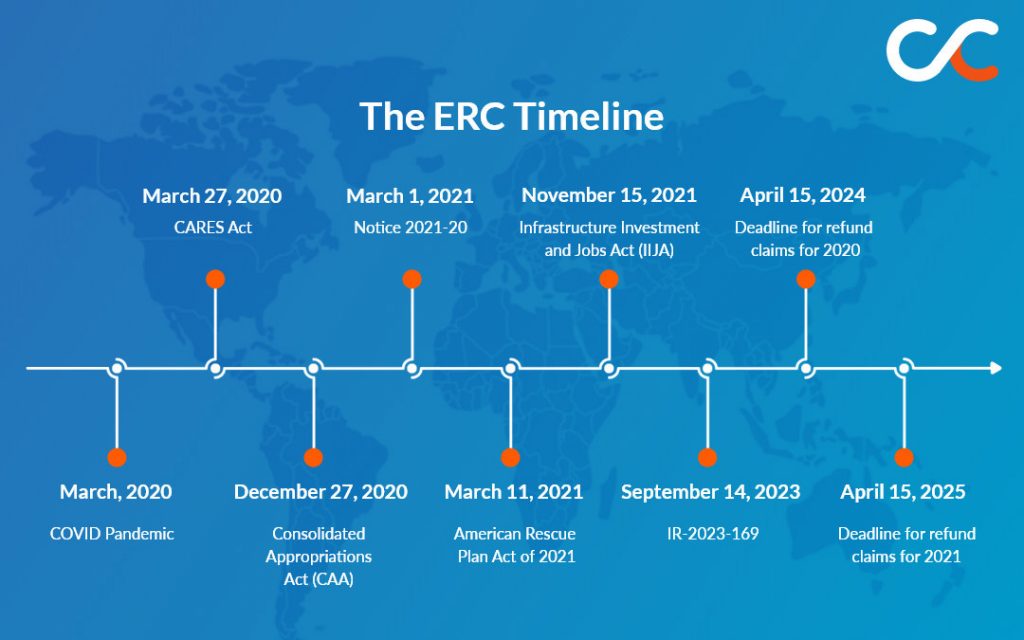
Breaking down the timeline of the Employee Retention Credit (ERC): How we got here and where are we going?
November 2, 2023
Courtesy of SBAM Approved Partner, Occams Advisory
Owners and executives of small- to medium-sized businesses would have been hard-pressed to not have heard at least something about the Employee Retention Credit, or ERC, within the last three years. The ERC is a fully refundable payroll tax refund introduced by Congress in 2020 to help SMBs keep employees on payroll during the COVID-19 pandemic (remember that?!). In a perfect world, understanding how your business qualifies and claims your ERC is cut and dry, but this is not a perfect world; this is the COVID era where government policies, congressional acts, and corresponding tax liabilities change with the stroke of a pen. The ERC can be worth up to $26,000 per employee per eligible employer. Join me for a deep dive (a 7 min read) into the timeline of change regarding the ERC, future dates to be aware of, and how Occams Advisory helps your organization Explore, Review, and Calculate your path to a proper and diligent claim.

The ERC began as part of the CARES Act, signed on March 27, 2020 by President Trump in response to the economic fallout from the COVID-19 pandemic in the United States. The CARES Act holds the crown for the largest economic stimulus package in history, sections of which were greeted with equal parts skepticism and fanfare. But it was very real. Individual citizens of the United States confirmed its reality when the first round of personal stimulus checks arrived in bank accounts on April 11, 2020 and business owners saw an immediate benefit through the mostly forgiven Paycheck Protection Program (PPP). Joining these two stimuli, the ERC was also included in the CARES Act, although at the time the credit was an “either/or” with the PPP and was limited to post-shutdown quarters of 2020. This was the first stage of evolution for the ERC, with many updates on the horizon.
On December 27, 2020, Congress passed, and President Trump signed, the Consolidated Appropriations Act (CAA). Perhaps the most important act relative to the ERC, the CAA included more stimulus relief combined with an omnibus spending bill to prevent a government shutdown. The CAA expanded the ERC with key points:
- The gross receipts threshold for a Significant Decline in Gross Revenue (SDGR) qualification was reduced to 20% for quarters in 2021
- The small employer cap for qualification was raised to 500 for quarters in 2021
- It included the Taxpayer Certainty and Disaster Relief Act, which held its own expansions for the ERC
- It increased the eligibility timeframe to include the first two quarters of 2021 (up to Sept 30, 2021)
- It allowed eligible employers to claim ERC up to 70% of qualified wages per eligible employee up to $10,000 per quarter
- Employers who took PPP loans were now able to claim the ERC for wages that were not treated as payroll costs in obtaining forgiveness of the PPP loan
The CAA is critical to understand, as at the time of its signing many businesses were locked in survival mode, confused (rightly) about ERC eligibility, or simply missed this news in the whirlwind.
On March 1, 2021, the IRS clarified the items included in the ERC with Notice 2021-20 is over one hundred pages long and defines the routes of eligibility:
EITHER
A. Significant Decline in Gross Revenue (SDGR)
OR
B. Full or Partial Suspension of Operations (FPSO), which had previously been more loosely defined
Included in the notice were 71 questions and answers providing guidance and examples that illustrated the rules of the ERC. It also explained when and how employers who previously claimed a PPP loan could claim the ERC for eligible quarters in 2020. Notice 2021-20 defined the meaning of “nominal impact” in relation to FPSO qualification and immediately gave business owners and tax advisors a better understanding of the ERC.
Just a few weeks later, on March 11, 2021, congress passed, and President Biden signed, the American Rescue Plan Act of 2021 (ARP). With the guidelines for ERC qualification laid out in Notice 2021-20, the ARP built on the measures in the CARES and CAA, and expanded (again) the ERC to include the third and fourth quarters of 2021 (later to be revised to just Q3). It also included two more notable routes to stimulate small businesses:
- The Recovery Startup Business Credit
- A provision of the ERC
- Wrote that small businesses launched after Feb 15, 2020 could claim up to $7,000 per employee per quarter in Qs 3&4 2021, capped at $100,000 and with average revenue brackets for qualification
- The Restaurant Revitalization Fund
- A grant program, separate from the ERC
- For restaurants and bars to meet payroll and other expenses
- I include the Restaurant Revitalization Fund because there is a common misconception that conflates it with the ERC
The United States economic recovery from COVID continued for months until November 15, 2021, when Congress passed the Infrastructure Investment and Jobs Act (IIJA). Also known as the “Bipartisan Infrastructure Law” (BIL), the IIJA was a response to worries about overspending and overeager stimulus. It was the first Act to roll back a small part of the ERC. Included in the IIJA was wording that retroactively eliminated an employers’ ability to claim ERC credits after September 30, 2021 (eliminating Q4 qualification) as had been laid out in the ARP of 2021. Due to its timing, the IIJA impacted businesses who were monetizing the ERC in real time for Q4 of 2021 and created a headache for these taxpayers. The IIJA was the final change to ERC laws and created the final framework for eligibility: SDGR or FPSO qualification in Qs 2,3,&4 of 2020 and Qs 1,2&3 in 2021; and Recovery Startup Business qualification for Quarters 3 and 4 of 2021.
Due to the nature of these acts, which made the ERC the most generous tax credit for SMB in history, enthusiasm threw fire to the wind and the IRS saw a gradually increasing influx of claims, both questionable and legitimate. “ERC fever” grew so rapidly, that bad actors began to take advantage of the confusing regulations and perplexed SMB leaders. Grandiose marketing and promotion gave way to a pop-up culture of overzealous ERC businesses and the IRS ran into a backlog for processing and auditing suspect claims. On September 14, 2023, the IRS issued IR-2023-169, a memo that announced a moratorium on processing new claims for the ERC through the end of the 2023 calendar year. In the memo, the IRS noted its concerns about improper claims and included advice on identifying the bad acting firms that could leave business owners in a bad situation if they were/are not prudent in vetting the tax advisors that they work with to claim the ERC. The memo also elicited more false information and overreactions from the public. Being a “moratorium” on processing new claims, the memo was a temporary cessation. Here are a few bullets on what the public gets wrong about IR-2023-169:
- It doesn’t “end the ERC”
- It is not an announcement of penalty for those who claimed the ERC
- It does not advise taxpayers against filing for the ERC
For additional guidance on IR-2023-169, this corresponding blog, written by the founder and CEO of Occams Advisory, covers the memo and how business owners can best navigate the changes it included.
The evolution of the ERC can be confusing, but it is empowering for SMB leaders to understand how we got here. As always, when dealing with tax refunds and the IRS, diligence and attention to detail is required. This is where Occams Advisory has a role to play. The ERC is an incredible and often overlooked opportunity for businesses, with a high-end potential value of up to $26,000 per employee per eligible employer. Again, exploration with a meticulous and reputable tax advisory firm is encouraged. The statute of limitations for claims for tax year 2020 expires on April 15, 2024, and for claims for tax year 2021 expires on April 15, 2025. Let us be your guide to simplify your ERC and reach out to us to schedule an “Explore, Review, Calculate” consultation. Click here to contact Occams now.